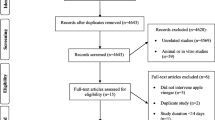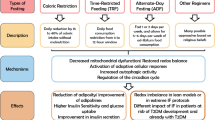Abstract
Aim
To compare changes in the oxidation–reduction balance and endothelial function before and after meal in patients with type 2 diabetes or impaired glucose tolerance and determine the effects of standard antioxidant supplementation.
Methods
Forty diabetics and 40 subjects with impaired glucose tolerance were compared with a control group. We assessed before and after a test meal (homogenized milkshake containing 80 g of saturated fat, amounting to 1,480 kcal), some reactive oxygen species, inflammation markers and flow-mediated vascular dilatation. These parameters were then reassessed after standard antioxidant treatment.
Results
After the meal, diabetics, subjects with impaired glucose tolerance and controls had higher levels of oxidant compounds compared to fasting levels. In subjects with diabetes and impaired glucose tolerance (IGT), Vascular Adhesion Molecule-1 and CRP were higher after the meal—diabetic subjects exhibited lower fasting flow-mediated dilatation, which deteriorated significantly after the meal. Antioxidant administration significantly improved the parameters investigated in all subjects.
Conclusions
In diabetic subjects, altered glycaemia and lipaemia are closely correlated with markers of systemic oxidative stress. Our results show that the abnormal changes in oxidative-reductive balance parameters are paralleled by similar changes in markers of endothelial dysfunction and inflammation at 4 h after ingestion of a fatty meal. Supplementation with a pool of antioxidants can reduce oxidative stress and inflammation in healthy subjects and, more importantly, in IGT patients. This previous aspect suggests that the timing of antioxidant supplementation has an important role in endothelium protection in healthy and pre-diabetic subjects, and along with prompt antioxidant treatment before irreversible endothelial damage has occurred, may have an important protective role in subjects with IGT—patients who require administration of adequate dietary antioxidants.
Similar content being viewed by others
References
Lautt WW (2007) Postprandial insulin resistance as an early predictor of cardiovascular risk. Ther Clin Risk Manag 3:761–770
Ginsberg HN (2000) Insulin resistance and cardiovascular disease. J Clin Invest 106:453–458
Ceriello A, Colagiuri S (2008) International Diabetes Federation guideline for management of postmeal glucose: a review of recommendations. Diabet Med 25:1151–1156
The Diabetes Control and Complications Trial Research Group (1995) The relationship of glycemic exposure to the risk of development and progression of retinopathy in the diabetes control and complication trial. Diabetes 44:968–983
Bonora E, Muggeo M (2001) Postprandial blood glucose as a risk factor for cardiovascular disease in type 2 diabetes: the epidemiological evidence. Diabetologia 44:2107–2114
Anderson RA, Evans ML, Ellis GR, Graham J, Morris K, Jackson SM (2001) The relationships between post-prandial lipaemia, endothelial function and oxidative stress in healthy individuals and patients with type 2 diabetes. Atherosclerosis 154:475–483
Doi H, Kugiyama K, Oka H, Sugiyama S, Ogata N, Koide S et al. (2000) Remnant lipoproteins induce pro atherothrombogenic molecules in endothelial cells through a redox-sensitive mechanism. Circulation 102:670–676
Wright E Jr, Scism-Bacon JL, Glass LC (2006) Oxidative stress in type 2 diabetes: the role of fasting and postprandial glycaemia. Int J Clin Pract 60:308–314
Ceriello A (2003) Coagulation activation in diabetes mellitus. The possible role of hyperglycaemia in the pathogenesis of diabetic complications. Diabetologia 46:9–16
Ceriello A, Esposito K, Picoli L, Ihnat LA, Thorpe JE, Testa R et al (2008) Oscillating glucose is more deleterious to endothelial function and oxidative stressthan mean glucose in normal and Type 2 diabetic patients. Diabetes 57:1349–1354
Wannmethee SG, Lowe GDO, Shager AG et al (2004) Insulin resistance, haemostatic and inflammatory markers and coronary heart disease risk factors in Type 2 diabetic men with and without coronary heart disease. Diabetologia 47:1557–15565
Evans JL, Goldfine ID, Maddux BA, Grodsky GM (2002) Oxidative stress and stress-activated signalling pathways: a unifying hypothesis of type 2 diabetes. Endocr Rev 23:599–622
Wen Y, Skidmore JC, Porter-Turner MM, Rea CA, Khokher MA, Singh B (2002) Relationship of glycation, antioxidant status and oxidative stress to vascular endothelial damage in diabetes. Diab Obes Metab 4:305–308
Hasainan B, Mooradian AD (2002) Antioxidant vitamins and their influence in diabetes mellitus. Curr Diab Rep 2:448–456
Lee DH, Falsom AR, Harnack L, Halliwell B, Jacobs DR Jr (2004) Does supplemental vitamin C increase cardiovascular disease risk in women with diabetes? Am J Clin Nutr 80:1194–2000
Upritchard JE, Sutherland WHF, Mann JI (2002) Effect of supplementation with tomato juice, vitamin E, and vitamin C on LDL oxidation and products of inflammatory activity in type 2 diabetes. Diabetes Care 23:733–738
Salonen JT, Nyyssonenk K, Salonen R, Antioxidant Supplementation in Atherosclerosis Prevention (ASAP) study (2000) A randomised study of the effects of vitamin E and C on 3-years progression of carotid atherosclerosis. J Int Med 284:377–386
Neri S, Signorelli SS, Torrisi B, Pulvirenti D, Mauceri B, Abate G et al (2005) Effects of antioxidant supplementation on postprandial oxidative stress and endothelial dysfunction: a single blind 15-day clinical trial in patient with untreated type 2 diabetes, subjects with impaired glucose tolerance, and healthy controls. Clin Ther 27:1764–1773
World Health Organization Study Group (1985) Diabetes mellitus. Technical report. Series 727. Geneva, WHO, pp 1–113
Rose GA, Blackburn H (1968) Cardiovascular survey methods. WHO, Geneva
Salonen R, Haapanen A, Salonen JT (1991) Measurement of intima-media thickness of the common carotid artery with high resolution B-mode ultrasonography: inter and intra-observer variability. Ultrasound Med Biol 17:225–230
Agwall S, Fagenberg B, Wendelberg I, Urbanavicin V, Vilkstrand J (1995) Carotid artery wall intima-media thickness associated with insulin-mediated glucose disposal in men at high and low coronary risk. Stroke 26:956–960
Graham JM, Higgins JA, Gillott T, Taylor T, Wilkinson J, Ford T et al (1996) A novel method for the rapid separation of lipoproteins using self generating gradients of iodixanol. Atherosclerosis 124:124–135
Ramsey M, Goodfellow J, Jones C, Luddington L, Lewis M, Henderson AH (1995) Endothelial control of arterial distensibility is impaired in chronic heart failure. Circulation 92:3212–3219
Inoue T, Sanibadi AR, Matsunaga R, Hosgi K, Yagushi I, Morooka S (1998) Impaired endothelium-dependent acetylcholine-induced coronary artery relaxation in patients with high serum remnant lipoprotein particles. Atherosclerosis 139:363–367
Plotnick GD, Correti MC, Vogel RA (1997) Effect of antioxidant vitamins on the transient impairment of endothelium-dependent brachial artery vasoactivity following a single high-fat meal. J Am Med Assoc 278:1682–1686
Ueda T, Maekawa T, Sadamitsu D, Oshita S, Ogino K, Nakamura K (1995) The determination of nitrite and nitrate in human blood plasma by capillary zone electrophoresis. Electrophoresis 16:1002–1004
Yagi K (1982) Assay for serum lipid peroxide level and its chemical significance. In: Yagi K (ed) Lipid peroxides in biology and medicine. Academic Press, New York, pp 223–242
Esterbauer H, Cheeseman KH (1990) Determination of aldehydic lipid peroxidation products: malonaldehyde and 4-hydroxynonenal. Methods Enzymol 18:407
Paglia DE, Valentine WN (1967) Studies on the quantitative and qualitative characterization on erythrocyte glutathione peroxidase. J Lab Clin Med 70:158
Basu S (2004) Isoprostanes: novel bioactive products of lipid peroxidation. Free Radic Res 38:105–122
Macy E, Hayes T, Tracy R (1997) Variability in the measurement of C-reactive protein in healthy subjects: implication for reference interval and epidemiological applications. Clin Chem 43:52–60
Fiotti N, Giansante C, Ponte E, Del Bello C, Calabrese S, Zacchi T et al (1999) Atherosclerosis and inflammation. Patterns of cytokine regulation in patients with peripheral arterial disease. Atherosclerosis 145:51–60
Grieve DJ, Avella MA, Elliot J, Botham KM (1998) The influence of chylomicron remnants on endothelial function in the isolated perfused rat aorta. Atherosclerosis 139:273–281
Vogel RA, Corretti MC, Plotnik GD (1997) Effect of a single high-fat meal. J Am Med Assoc 278:1682–1686
Whiteside CI (2005) Cellular mechanism and treatment of diabetes vascular complications converge on reactive oxygen species. Curr Hypertens Resp 5:148–154
Huang HY, Appel LJ, Croft KD, Miller ER 3rd, Mori TA, Puddey IB (2002) Effects of vitamin C and vitamin E on in vivo lipid peroxidation: results of a randomized controlled trial. Am J Clin Nutr 76(3):549–555
Sampson MJ, Davies IR, Brown JC, Ivory K, Hughes DA (2002) Monocyte and neutrophil adhesion molecule expression in type 2 diabetes and control patients. Arter Thromb Vasc 22:1187–1193
Ceriello A (2000) The post prandial state and cardiovascular disease: relevance to diabetes mellitus. Diabetes Metab Res Rev 16:125–132
Halliwell B (1995) How characterize an antioxidant: an update. In: Rice-Evans C, Halliwell B, Lunt GG (eds) Free radicals and oxidative stress: environment, drugs and food additives. Portland Press, London, pp 73–102
Brownlee M (2001) Biochemistry and molecular cell biology of diabetic complications. Nature 414:813–820
Esposito K, Maiorino MI, Ciotola M, Di Palo C, Scognamiglio P, Gicchino M et al (2009) Effects of a Mediterranean-style diet on the need for antihyperglycemic drug therapy in patients with newly diagnosed type 2 diabetes: a randomized trial. Ann Intern Med 151:306
Acknowledgments
This study was partially supported by a grant (60%) from the Italian Ministry of University. There was no industrial financial support for the study; there are no real or potential conflicts of interest.
Conflict of interest statement
None.
Author information
Authors and Affiliations
Corresponding author
Electronic supplementary material
Below is the link to the electronic supplementary material.
Rights and permissions
About this article
Cite this article
Neri, S., Calvagno, S., Mauceri, B. et al. Effects of antioxidants on postprandial oxidative stress and endothelial dysfunction in subjects with impaired glucose tolerance and Type 2 diabetes. Eur J Nutr 49, 409–416 (2010). https://doi.org/10.1007/s00394-010-0099-6
Received:
Accepted:
Published:
Issue Date:
DOI: https://doi.org/10.1007/s00394-010-0099-6




